Shenandoah Telecommunication Bundle
How has Shenandoah Telecommunications Company Evolved?
Ever wondered how a small rural telephone system transformed into a major player in the telecommunications industry? This article unveils the Shenandoah Telecommunication SWOT Analysis, tracing the remarkable journey of Shenandoah Telecommunications (Shentel) from its humble beginnings in 1902. Explore the significant milestones and strategic decisions that shaped this company's impressive growth and its impact on the telecom landscape.
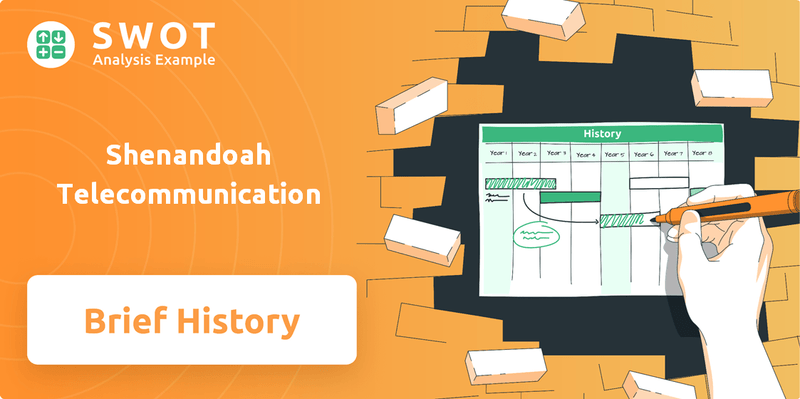
From connecting rural communities to providing cutting-edge broadband services, Shentel's history is a testament to its adaptability and vision. This deep dive into the Shentel history will examine the company's early services and expansion over time. Learn about the key acquisitions and mergers that fueled its growth, and discover how Shentel continues to evolve in the dynamic telecom industry.
What is the Shenandoah Telecommunication Founding Story?
The founding story of Shenandoah Telecommunications, or Shentel, began in January 1902. It was initially incorporated as the Farmers' Mutual Telephone System of Shenandoah County (FMTS). This marked the start of a long journey for the telecommunications company.
The primary goal was to bring telephone service to the rural areas of Shenandoah County, Virginia. This was a response to the lack of communication infrastructure beyond the towns. The founders aimed to bridge this gap.
Five residents from Edinburg and Lantz's Mills started the company. They recognized the need for telephone service in sparsely populated areas. They took the initiative to build and maintain their own lines. They formed a non-profit entity where each subscriber was a stockholder. This cooperative approach focused on providing essential connectivity rather than immediate profit.
Shentel's early services focused on basic telephone connections. The company connected homes through grounded lines. By 1906, Farmers Mutual served around 400 customers. They used 50 lines to provide service. The company's name reflected its purpose.
- The business model was cooperative.
- Subscribers owned stock in the company.
- The early 20th century saw growing demand for rural communication.
- This demand shaped the company's community-centric approach.
The economic conditions of the early 20th century played a key role in Shentel's creation. The demand for communication in rural areas was growing. This influenced the company's community-focused approach. The company's history reflects its commitment to serving its customers. To learn more about the company's values, you can read about the Mission, Vision & Core Values of Shenandoah Telecommunication.
Shenandoah Telecommunication SWOT Analysis
- Complete SWOT Breakdown
- Fully Customizable
- Editable in Excel & Word
- Professional Formatting
- Investor-Ready Format
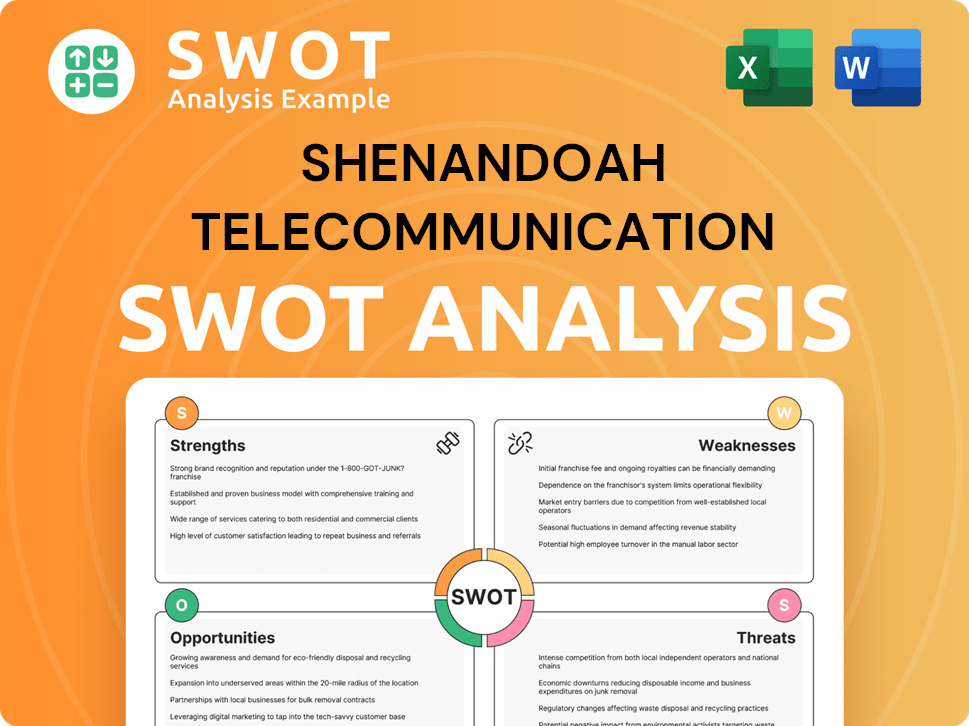
What Drove the Early Growth of Shenandoah Telecommunication?
The early years of Shenandoah Telecommunications, or Shentel, were marked by steady expansion within Shenandoah County. This period laid the groundwork for its future growth and diversification within the telecommunications sector. This Shentel history reveals the company's strategic moves and technological advancements.
In 1911, Farmers Mutual Telephone System, later known as Shentel, acquired the Shenandoah County Telephone Company, becoming the sole provider in the county. The acquisition of Ashby Lee Telephone System in 1945 further solidified its local presence. These early acquisitions were crucial for establishing a strong foundation in the region.
Under Warren B. French, Jr., the company transitioned to automatic, long-distance dialing by 1962, making its subscribers the first in Virginia to dial their own long-distance calls. The company officially changed its name to Shenandoah Telephone Company in 1960. By 1969, revenues exceeded $1 million.
The 1970s saw the number of telephones almost double, from 11,000 to 19,287. Responding to changes in the telecommunications landscape, Shentel introduced cable TV service in 1980. The formation of Shenandoah Telecommunications Company (Shentel) as a holding company in 1981 marked a significant shift.
Shentel built its fiber optic network in 1984. Key subsidiaries like ShenTel Service Company and Shenandoah Mobile Company were formed in 1984, followed by Shenandoah Long Distance Company in 1987. In 1990, Shenandoah Cellular launched, offering cellular service to a rural area.
Shenandoah Telecommunication PESTLE Analysis
- Covers All 6 PESTLE Categories
- No Research Needed – Save Hours of Work
- Built by Experts, Trusted by Consultants
- Instant Download, Ready to Use
- 100% Editable, Fully Customizable
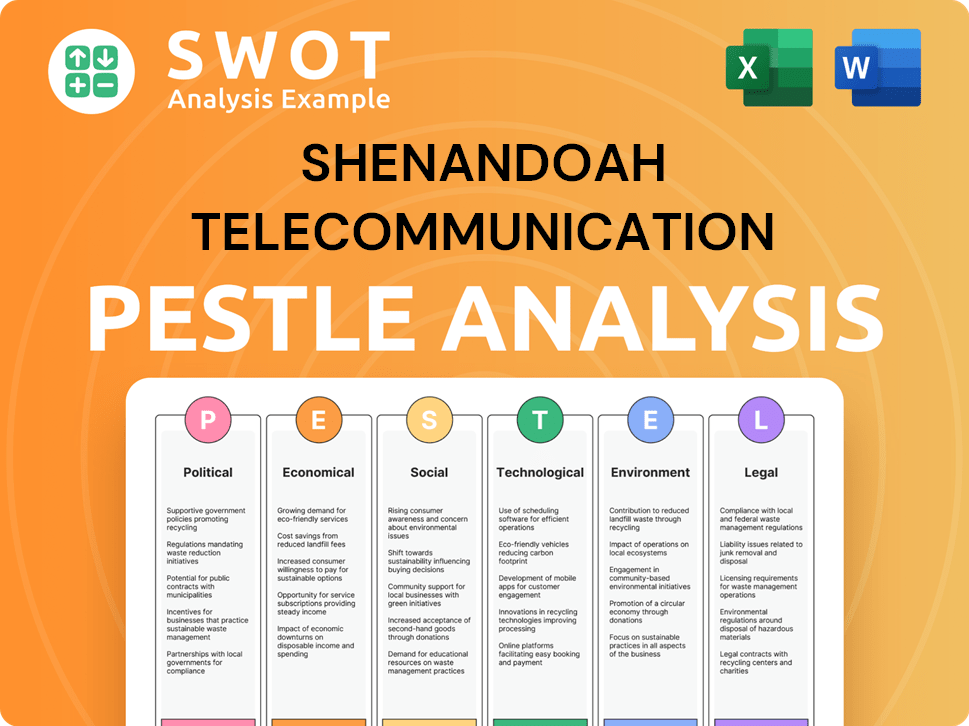
What are the key Milestones in Shenandoah Telecommunication history?
The Shentel history is marked by strategic pivots and expansions, reflecting its evolution in the telecommunications sector. From its early days as a local telephone provider to its current focus on broadband services, the company has consistently adapted to market changes and technological advancements.
| Year | Milestone |
|---|---|
| 1980s | Launched its fiber optic network, a crucial step for future broadband services. |
| 1990 | Pioneered rural cellular service in Virginia. |
| 1994 | Introduced internet access to its customers. |
| 1999 | Became a Sprint PCS Affiliate. |
| 2008 | Acquired Rapid Communications. |
| 2010 | Acquired Jet Broadband. |
| 2016 | Acquired nTelos for $640 million, becoming the sixth-largest public wireless company in the U.S. |
| 2019 | Launched Glo Fiber, offering high-speed internet. |
| 2020 | T-Mobile acquired Shentel's wireless business for $1.95 billion. |
| 2023 | Acquired Horizon Telcom in Ohio for $385 million. |
| 2024 | Agreed to sell its cell tower portfolio for $310.3 million. |
Shentel's innovations have been key to its growth, particularly in the development of its infrastructure. The early adoption of fiber optic technology laid the groundwork for its broadband services, and the launch of Glo Fiber marked a significant advancement in internet speeds.
Shentel's early investment in fiber optics was a forward-thinking move. This technology provided a robust foundation for delivering high-speed internet and other advanced services.
Shentel was a pioneer in bringing cellular service to rural areas in Virginia. This initiative expanded communication access to underserved communities.
Introducing internet access to its customers in 1994 was a major step. This move positioned the company to capitalize on the growing demand for online services.
The launch of Glo Fiber, offering high-speed internet, was a significant innovation. This service has expanded the company's footprint and service offerings.
The acquisition of nTelos in 2016 was a strategic move. This boosted Shentel's wireless subscriber base and expanded its market presence.
The acquisition of Horizon Telcom in 2023 expanded Shentel's fiber network. This strategic move strengthened its position in the commercial fiber business.
Challenges for Shentel have included navigating the competitive landscape and managing strategic shifts. The transition after the sale of its wireless business and the rapid expansion of its fiber footprint have presented ongoing hurdles.
The sale of the wireless business to T-Mobile was a major strategic shift. This required restructuring and a new focus on broadband services.
The telecom industry is highly competitive, with major players vying for market share. Shentel has had to compete with larger companies.
Expanding the fiber network requires significant investment and faces logistical challenges. This rapid expansion has required careful planning and execution.
Integrating acquired companies like Horizon Telcom can be complex. This involves merging operations, systems, and cultures.
Adapting to changing market demands and technological advancements is crucial. Shentel must continually evolve to meet customer needs.
Managing finances during acquisitions and divestitures requires careful planning. The company must ensure financial stability and growth.
Shenandoah Telecommunication Business Model Canvas
- Complete 9-Block Business Model Canvas
- Effortlessly Communicate Your Business Strategy
- Investor-Ready BMC Format
- 100% Editable and Customizable
- Clear and Structured Layout
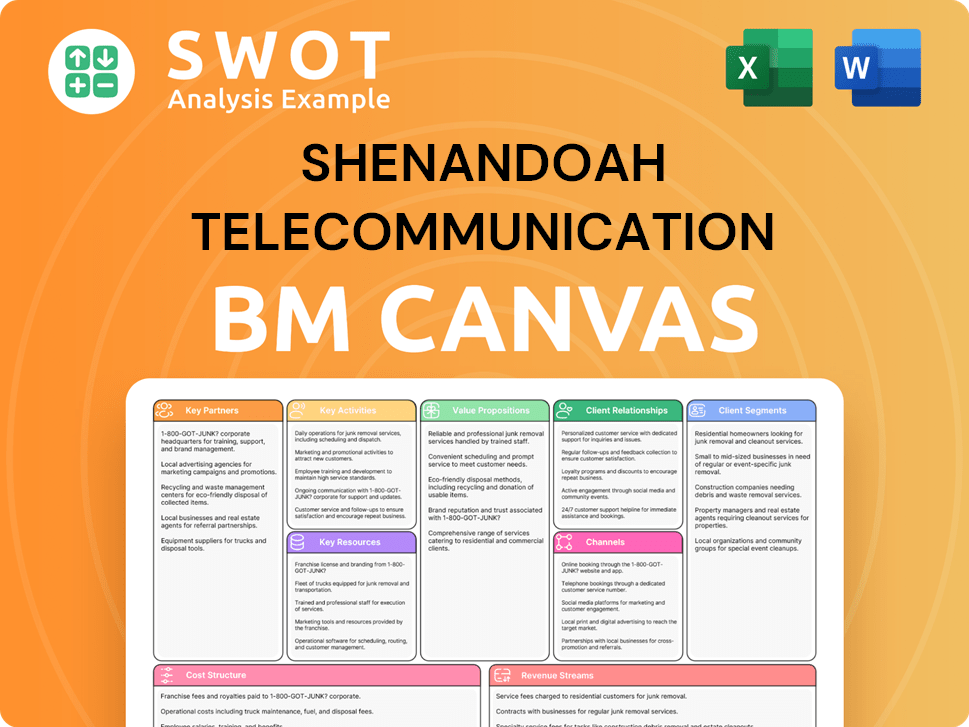
What is the Timeline of Key Events for Shenandoah Telecommunication?
The Shentel history is a story of adaptation and growth in the telecommunications sector, evolving from a rural telephone provider to a significant player in fiber broadband. From its origins in 1902 as Farmers Mutual Telephone System, the company has consistently expanded its services and infrastructure, embracing new technologies to meet the changing needs of its customers. The company's journey includes strategic acquisitions, partnerships, and a strong focus on fiber optic network development, positioning it for continued success in the competitive telecom landscape.
| Year | Key Event |
|---|---|
| 1902 | Farmers Mutual Telephone System (FMTS) incorporated in Shenandoah Valley, Virginia, providing rural telephone service. |
| 1960 | FMTS changed its name to Shenandoah Telephone Company. |
| 1980 | Shenandoah Telephone Company introduced Cable TV service. |
| 1981 | Shenandoah Telecommunications Company (Shentel) formed as a holding company for telephone and cable TV operations. |
| 1984 | Shentel began building its fiber optic network and introduced mobile and paging services. |
| 1990 | Shenandoah Cellular launched, offering cellular service to a rural area in Virginia. |
| 1994 | Internet service became available to Shentel customers. |
| 1999 | Shentel partnered with Sprint as its first Sprint PCS Affiliate. |
| 2016 | Shentel acquired nTelos for $640 million, becoming the sixth-largest public wireless company in the U.S. |
| 2019 | Shentel launched Glo Fiber, its fiber-to-the-home internet service. |
| 2020 | T-Mobile acquired Shentel's wireless business for $1.95 billion. |
| 2023 | Glo Fiber launched 5 Gig fiber internet service; Shentel acquired Horizon Telcom for $385 million. |
| 2024 | Shentel reported full-year revenue of $328.1 million, a 21.9% increase year-over-year, largely due to the Horizon acquisition. Glo Fiber Expansion Markets data customers grew 56% year-over-year to over 65,000. |
| 2024 (March) | Shentel agreed to sell its cell tower portfolio for $310.3 million. |
| 2025 (February) | Glo Fiber construction is underway in Lancaster, Ohio, expanding service to approximately 10,000 additional homes and businesses by late 2025. |
| 2025 (April) | Shentel reported Q1 2025 revenue of $87.9 million, up 26.9% compared to Q1 2024, with Glo Fiber Expansion Markets data subscribers growing 51% to approximately 71,000. |
Shentel is heavily focused on expanding its fiber broadband service, Glo Fiber. The company plans to reach approximately 600,000 homes and businesses with Glo Fiber by the end of 2026. This expansion is a key strategic initiative for the company.
In 2024, Shentel added over 103,000 new fiber passings and more than 1,400 new route miles of fiber. As of February 2025, its fiber network exceeded 16,800 route miles. They anticipate adding more than 100,000 fiber passings in each of the next two years.
Shentel's Q1 2025 revenue was $87.9 million, up 26.9% compared to Q1 2024. Glo Fiber Expansion Markets data subscribers grew 51% to approximately 71,000. Shentel expects its long-term compound annual growth rates to return to levels achieved after the Glo Fiber launch in 2019.
The company is focused on expanding Glo Fiber into new markets, leveraging its extensive regional fiber network. Shentel's strategy is rooted in its original mission of delivering advanced telecommunications services to rural and underserved communities. This focus on fiber broadband expansion is central to Shentel's future plans.
Shenandoah Telecommunication Porter's Five Forces Analysis
- Covers All 5 Competitive Forces in Detail
- Structured for Consultants, Students, and Founders
- 100% Editable in Microsoft Word & Excel
- Instant Digital Download – Use Immediately
- Compatible with Mac & PC – Fully Unlocked
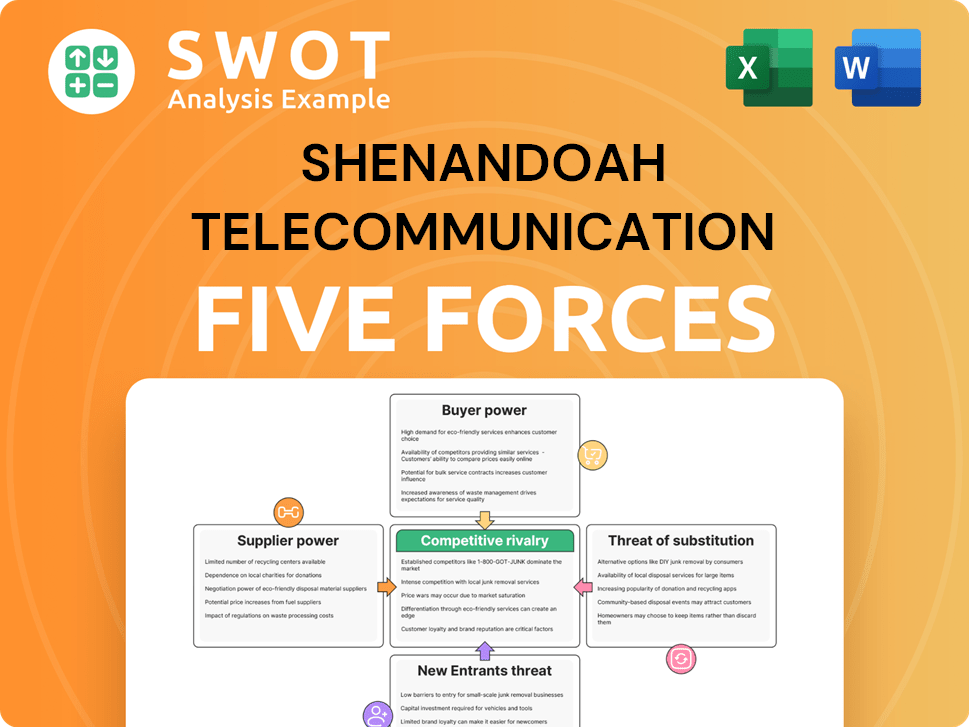
Related Blogs
- What is Competitive Landscape of Shenandoah Telecommunication Company?
- What is Growth Strategy and Future Prospects of Shenandoah Telecommunication Company?
- How Does Shenandoah Telecommunication Company Work?
- What is Sales and Marketing Strategy of Shenandoah Telecommunication Company?
- What is Brief History of Shenandoah Telecommunication Company?
- Who Owns Shenandoah Telecommunication Company?
- What is Customer Demographics and Target Market of Shenandoah Telecommunication Company?
Disclaimer
All information, articles, and product details provided on this website are for general informational and educational purposes only. We do not claim any ownership over, nor do we intend to infringe upon, any trademarks, copyrights, logos, brand names, or other intellectual property mentioned or depicted on this site. Such intellectual property remains the property of its respective owners, and any references here are made solely for identification or informational purposes, without implying any affiliation, endorsement, or partnership.
We make no representations or warranties, express or implied, regarding the accuracy, completeness, or suitability of any content or products presented. Nothing on this website should be construed as legal, tax, investment, financial, medical, or other professional advice. In addition, no part of this site—including articles or product references—constitutes a solicitation, recommendation, endorsement, advertisement, or offer to buy or sell any securities, franchises, or other financial instruments, particularly in jurisdictions where such activity would be unlawful.
All content is of a general nature and may not address the specific circumstances of any individual or entity. It is not a substitute for professional advice or services. Any actions you take based on the information provided here are strictly at your own risk. You accept full responsibility for any decisions or outcomes arising from your use of this website and agree to release us from any liability in connection with your use of, or reliance upon, the content or products found herein.